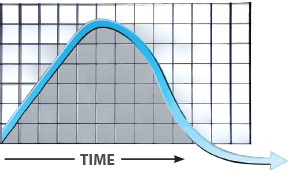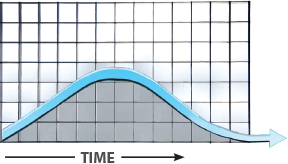The glycemic index measures the rate by which dietary carbohydrates are digested and absorbed into the bloodstream. The glycemic index has been around since 1981, yet a great majority of people do not know about this concept. The best way to understand the glycemic index is to draw a comparison between orange juice and a whole orange.
ORANGE JUICE ABSORBS QUICKLY
Your digestive system can be compared to a sponge that readily absorbs fluid. Orange juice would go straight through a sponge and directly into your bloodstream.

AN ORANGE ABSORBS SLOWLY
A whole orange will take a longer time to absorb because of its fiber content. The average glass of orange juice has the same amount of carbohydrates as 3 oranges.

Low glycemic, or “slow absorbing” fruits, vegetables and whole grains are beneficial because they take an extended time for the body to break down and convert into pure glucose (blood sugar). Slow absorbing carbohydrates prevent the excess production of the hormone insulin, which is the body’s only fat storing hormone.
The glycemic index is a 0 to 100 scale that measures the absorption rate of a carbohydrate source. To determine the glycemic index, ten test subjects are fed 50 grams of a carbohydrate-containing food and their blood sugar levels are plotted on a graph for the time frame of 2 hours following the meal. The area of the graph is calculated as the glycemic index. Carbohydrates that absorb quickly will yield a high numerical value and slow absorbing carbohydrates a reduced number. For example, pasta has a low glycemic index (37) and therefore absorbs slowly into the body. Pasta only becomes a problem when it is eaten in excessive quantities.
HIGH GLYCEMIC CARBS
Consuming high glycemic foods will cause a greater rise in blood sugar followed by a sudden decrease as the hormone insulin fights to bring blood sugar back down to normal levels. The problem is, insulin will eventually push blood glucose below normal levels, a situation detrimental to the functioning of the brain and central nervous system. The shaded area is calculated as the glycemic index of a food. The quicker the rise in blood sugar, the steeper the curve and the surface area of the graph will be larger.

LOW GLYCEMIC CARBS
Slow absorbing carbohydrates will cause a slow and steady rise in blood sugar. In this case, only a small amount of insulin is needed to bring the sugar back down to normal levels. The brain and body (muscles) will get a steady flow of fuel without being overfed. The shaded area for low glycemic foods is smaller and are therefore a lower glycemic number is calculated.

FRUCTOSE (FRUIT SUGAR)
Many people avoid fruit because 70% of the sugar found in most fruit is fructose, a simple sugar. Although fructose is a single unit of sugar, it takes a long time for the body to convert it into actual blood sugar (glucose) because fructose must travel to the liver before it is chemically transformed into glucose. The fiber content further blunts the glycemic response of a fruit. The recommended serving for fruits like apples, oranges and pears is no more than 2-3 whole fruits per day.
BANANAS
Young bananas are mostly made of fructose, but as they ripen they crystallize into pure glucose. The riper a banana, the faster it will absorb. Either way, no fruit or vegetable in its natural state should ever be considered “bad.” Nature does not produce many fruits or vegetables that would be harmful for humans to eat as nutritious food.
CARROTS
Carrots were originally given a high glycemic rating by a faulty study. As a result many people stopped eating carrots. Since then carrots have been reevaluated and given their appropriate low glycemic rating. A medium carrot has only has 5 grams of carbohydrate. For carrots to absorb quickly, you would have to eat over a pound of them at one sitting.
OATMEAL
The absolute best type of oatmeal is steel cut oatmeal because it’s the least processed and has the lowest glycemic index score. The only downfall to steel cut oatmeal is the preparation time. Manufacturers flatten steel cut oats to form old fashioned or 5-minute cooking oatmeal. This kind of oatmeal should be a staple to your diet program because of its low glycemic index and convenience. If you were to further chop 5 minute oatmeal into smaller bits and pieces, you would have quick cooking, or 1 minute cooking oatmeal. Avoid quick cooking oatmeal because of its high glycemic index.

BREADS
Most breads are high glycemic, however there are lower glycemic versions available. Choose sourdough, rye, pumpernickel or stone ground whole wheat. These breads absorb slower then most other types of bread because of the amount of fiber or the type of dough.
PASTA
People usually throw pasta into the unfavorable carbohydrate category because it is a complex carbohydrate. Contrary to this belief, pasta is actually a slow absorbing food. Pasta only becomes high glycemic when it’s eaten in excessive quantities. Choose whole wheat, high fiber pasta because the fiber content takes up space and this allows you to eat a greater serving size.
RICE AND POTATOES
Complex carbohydrates (long chains of glucose) come in many different shapes and lengths. The structure of the glucose chain found in parboiled, or converted rice has been found to have a lower glycemic index because it has a compact structure that delays the time it takes for digestive juices to break it down. The same is true for New, or Red Bliss potatoes.
Factors that Contribute to the Glycemic Index
HOW MUCH FIBER IT HAS
Networks of fiber act as a physical barrier, which prevents sugar from entering into the bloodstream at such a fast pace.
THE STRUCTURE OF THE SUGAR
The physical structure of the sugar also contributes to the glycemic index. The only sugar that your brain and nervous system can burn is glucose. Other simple sugars like fructose and galactose (milk sugar) need to be chemically converted to glucose in the body. This process takes time, and ends up lowering the glycemic index the food.
THE ACIDITY OF THE FOOD
Sourdough bread contains a fermented dough that is acidic in nature. Acidic foods change the stomachs PH level, delaying the stomach’s transfer of food into the small intestines. Consequently the glycemic index of sourdough bread is lowered. It is for this same reason, that adding vinegar to a meal lowers the glycemic response of the meal.
HOW MUCH FAT YOU EAT WITH THE MEAL
Like fiber, fat acts like a physical barrier that prevents the sugar from rushing into the bloodstream too quickly.
THE GLYCEMIC LOAD
The glycemic load is a concept that takes into consideration the quality of a carbohydrate (glycemic index) vs. the quantity (serving size) a person eats at one sitting. The glycemic index can be deceiving because some foods can absorb quickly if too much is eaten at one time. Pasta is a good example of a food that has a low glycemic index and a potentially high glycemic load. Pasta has a low blood sugar response when eaten in the correct portion size, however eating too much pasta at one meal can significantly raise blood sugar levels. On the other hand, you can’t possibly eat enough broccoli in one sitting to raise your blood sugar significantly. Foods like green leafy vegetables can not be tested for their glycemic index since their level of digestible sugars is too low. Generally speaking there is no need to worry about the glycemic load when using the Core Fat Loss food combining system because portion control has already been established!